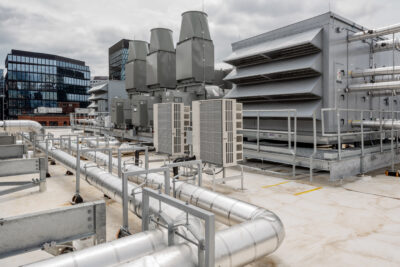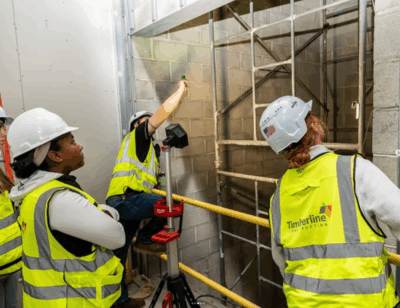As the tough tech sector accelerates and the need for adequate growth space increases, teams are facing a new reality. These companies move fast and require highly specialized facilities, yet rarely have the luxury of time or budget for ground-up construction.
To keep pace, many are repurposing existing or unconventional buildings into state-of-the-art technology hubs. It’s a smart strategy, but one that demands precision, foresight and deep technical expertise. Timberline has become a trusted partner in this space, helping clients unlock the potential of existing structures while meeting the demanding requirements of advanced technology operations.
Timberline’s Approach to Tough Tech Retrofits

New roof system for a building repositioning
Transforming existing buildings into high-performance environments for advanced technology use is far more complex than a traditional fit-out. These projects must balance sophisticated systems and infrastructure against the limitations of older or previously occupied spaces. For our Massachusetts clients, recent energy code updates further compound these challenges with new efficiency standards that can be difficult and costly to achieve in existing buildings.
We minimize risk on these projects with a proactive approach that’s anchored in early planning, technical coordination and close collaboration with clients and design teams. Three areas of focus consistently drive successful outcomes on our tech-heavy and manufacturing retrofit projects:
- Thorough Existing Condition Assessments are Critical
Every successful retrofit begins with understanding what’s already there. Our team works closely with engineers and design partners to perform detailed evaluations of structural, MEP and envelope conditions to define the true parameters of the project early on. We regularly leverage BIM (Building Information Modeling) to streamline coordination, accurately detect existing conditions and enhance project outcomes. On a recent 190,000 SF advanced manufacturing renovation, we utilized BIM scanning for system clash detection, identifying and resolving conflicts before construction began. This proactive approach allowed us to prefabricate key manufacturing components, accelerate production and eliminate rework. By uncovering challenges early, we consistently make informed recommendations that drive time and cost savings for our clients. - Feasibility & Phasing Strategies to Protect Ongoing Operations
Because many tough tech retrofits occur within active facilities, Timberline emphasizes detailed phasing and logistics planning from the start. We develop multi-phase construction strategies that maintain business continuity and minimize downtime for ongoing operations. On a five-phase renovation for Revvity, spanning two occupied buildings, sequencing construction around active lab operations is a 24/7 job. Each phase is carefully planned so one group’s relocation enables work to begin in the next area. We don’t start a phase until every material and equipment item is ready to go, reducing idle time and preventing disruptions. Even planned power shutdowns and air handler outages are tightly coordinated with facilities staff to protect sensitive environments and maintain uninterrupted operations. - Integrating HVAC, Electrical and Mechanical Systems
Advanced technology facilities rely on complex infrastructure and success depends on how seamlessly those systems integrate. Timberline manages this through rigorous preconstruction coordination, working closely with engineers and trade partners to align design intent with real-world constructability. At a current advanced manufacturing project, we upgraded HVAC and electrical systems to accommodate significant heat loads. By pre-releasing rooftop and chiller equipment early, we stayed ahead of long lead times and maintained schedule certainty. This level of foresight keeps construction moving efficiently while mitigating risk.
These processes – detailed assessments, phased planning and proactive coordination – are what enable Timberline to avoid costly redesigns, rework and schedule delays that often derail complex retrofits.
Tackling the Infrastructure Bottleneck: Power
Even with strong planning, one challenge consistently defines advanced technology retrofits: power. As operations become more energy-intensive, many existing buildings simply don’t have the capacity to support the required loads. Without adequate power, construction schedules and operational timelines can be disrupted. Since 2021, Timberline has led early engagement on advanced manufacturing and data center projects to evaluate capacity, forecast demand and secure utility approvals, often months ahead of typical schedules.

Site tour of an active advanced technology project
On a campus project in Westford, MA, for a global technology company, the existing building was originally designed for office use and lacked the electrical capacity to support an expansion of 400 IT racks. Timberline worked closely with National Grid to increase the power supply, tapping into underground lines and installing a new transformer. For another healthcare technology client, we managed a significant power increase from 3,000 to 7,000 kilowatts by pre-releasing long-lead electrical and mechanical equipment to align with critical construction milestones. At Revvity, electrical loads needed to double from 2,000 to 4,000 kilowatts. Through early coordination with the utility provider and engineering team, our team secured infrastructure upgrades and approvals well ahead of construction—keeping the project on schedule and fully powered for future growth. These examples demonstrate that through proactive planning and close collaboration, power availability doesn’t become a barrier to innovation.
Looking Ahead
As the Tough Tech ecosystem evolves, projects will only grow more complex. Timberline’s advantage lies in our ability to anticipate these challenges and build solutions into every stage of the process. From rigorous assessments to coordinated infrastructure planning, we are helping clients modernize faster, smarter and with greater certainty.
We’re proud to play a role in transforming existing buildings into high-performance facilities that drive innovation and growth across the region. If you missed our last post, we gave an introduction to tough tech and why it’s booming. Next, we’ll be doing a deep dive on battery and energy innovation. Sign up at the link below to stay in touch!

